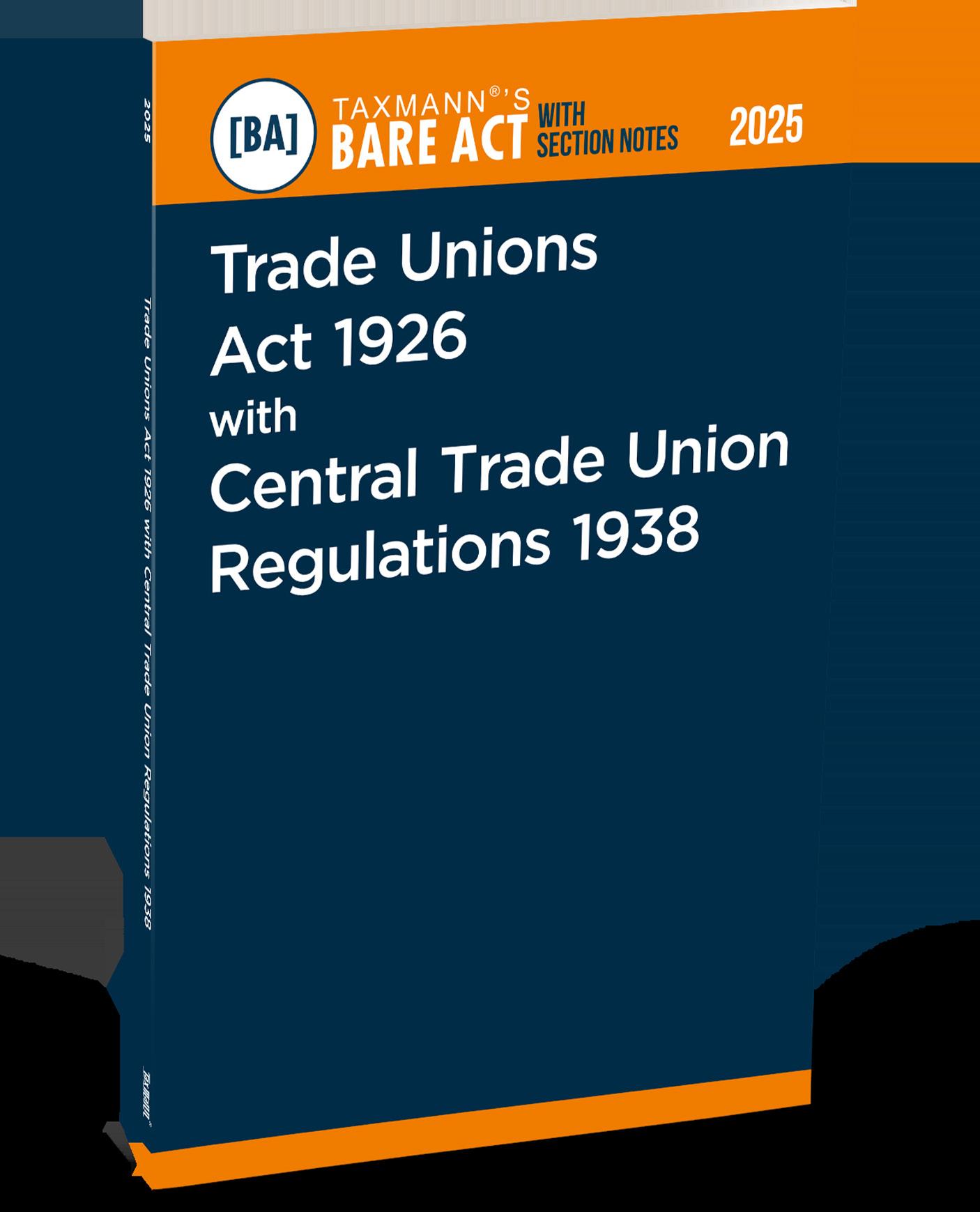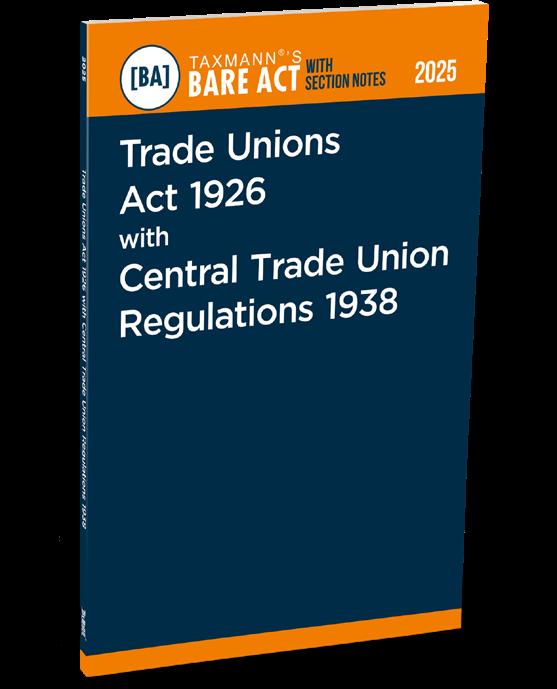


















[16 OF 1926]*
An Act to provide for the registration of Trade Unions and in certain respects to define the law relating to registered Trade Unions 1[* * *].
WHEREAS it is expedient to provide for the registration of Trade Unions and in certain respects to define the law relating to registered Trade Unions 1[* * *].
It is hereby enacted as follows:—
Short title, extent and commencement.
1. (1) This Act may be called the 2[* * *] Trade Unions Act, 1926.
3[(2) It extends to the whole of India 4[* * *],]
(3)It shall come into force on such date as the Central Government may, by notification in the Official Gazette, appoint.
Definitions.
2. In this Act 5[“the appropriate Government” means, in relation to Trade Unions whose objects are not confined to one State, the Central Government, and in relation to other trade unions, the State Government, and], unless there is anything repugnant in the subject or context,—
(
a) “executive” means the body, by whatever name called, to which the management of the affairs of a Trade Union is entrusted;
(b) 6[office bearer], in the case of a Trade Union, includes any member of the executive thereof, but does not include an auditor;
*Dated 25-3-1926.
1. Words “in the Provinces of India” omitted by the Indian Trade Unions (Amendment) Act, 1960, w.e.f. 21-9-1960.
2. Word “Indian” omitted by the Indian Trade Unions (Amendment) Act, 1964, w.e.f. 1-41965.
3. Substituted by the Adaptation of Laws order, 1950.
4. Words “except the State of Jammu and Kashmir” omitted by the Central Labour Laws (Extension to Jammu and Kashmir) Act, 1970, w.e.f. 1-9-1971. Earlier these words were substituted by the Part B States (Laws) Act, 1951.
5. Inserted by the Government of India (Adaptation of Indian Laws) Order, 1937.
6. Substituted for “officer” by the Indian Trade Unions (Amendment) Act, 1964, w.e.f. 1-4-1965.
†Shall be repealed by the Industrial Relations Code, 2020, with effect from a date yet to be notified.
(c) “prescribed” means prescribed by regulations made under this Act;
(d) “registered office” means that office of a Trade Union which is registered under this Act as the head office thereof;
(
e) “registered Trade Union” means a Trade Union registered under this Act;
7[(f) “Registrar” means—
(i) a Registrar of Trade Unions appointed by the appropriate Government under section 3, and includes any Additional or Deputy Registrar of Trade Unions; and
(ii) in relation to any Trade Union, the Registrar appointed for the State in which the head or registered office, as the case may be, of the Trade Union is situated;]
(g) “trade dispute” means any dispute between employers and workmen or between workmen and workmen, or between employers and employers which is connected with the employment or non-employment, or the terms of employment or the conditions of labour, of any person, and “workmen” means all persons employed in trade or industry whether or not in the employment of the employer with whom the trade dispute arises; and
(
h) “Trade Union” means any combination, whether temporary or permanent, formed primarily for the purpose of regulating the relations between workmen and employers or between workmen and workmen, or between employers and employers, or for imposing restrictive conditions on the conduct of any trade or business, and includes any federation of two or more Trade Unions:
Provided that this Act shall not affect—
(i) any agreement between partners as to their own business;
(ii) any agreement between an employer and those employed by him as to such employment; or
(iii) any agreement in consideration of the sale of the goodwill of a business or of instruction in any profession, trade or handicraft.
SECTION NOTES
2.1 Definition of “Registrar” [Section 2(f)]
2.1-1 Registrar as Appointed Authority [Clause (i)]
“Registrar” means:
A Registrar of Trade Unions appointed by the appropriate Government under section 3.
This also includes:
7. Substituted
Any Additional Registrar, or Any Deputy Registrar of Trade Unions.
2.1-2 registrar in relation to jurisdiction [Clause (ii)]
In relation to any Trade Union, the “Registrar” refers to:
The Registrar appointed for the State in which:
The head office, or
The registered office, of the Trade Union is situated.
2.2 Definition of “Trade Dispute” and “Workmen” [Section 2(g)]
2.2-1 Definition of “Trade Dispute”
A “trade dispute” means:
Any dispute between:
Employers and workmen, or Workmen and workmen, or
Employers and employers,
Where the dispute is connected with:
Employment, Non-employment,
Terms of employment, or
Conditions of labour of any person.
2.2-2 Definition of “Workmen”
“Workmen” includes:
All persons employed in trade or industry, Whether or not they are in the employment of the employer with whom the trade dispute has arisen.
2.3 Definition of “Trade Union” [Section 2(h)]
2.3-1 Core definition of trade union
A “Trade Union” means any combination, whether: Temporary, or Permanent,
Formed primarily for the purpose of:
Regulating relations between:
Workmen and employers, Workmen and workmen, or Employers and employers, Or for imposing restrictive conditions on the conduct of any trade or business.
The definition expressly includes:
Any federation of two or more Trade Unions.
2.3-2 Exclusions from the definition [Proviso]
The Act does not affect the following private agreements:
Agreements between partners concerning their own business.
Agreements between an employer and his employees regarding employment terms.
Agreements relating to:
The sale of goodwill, or Instruction in any profession, trade, or handicraft.
Appointment of Registrars.
3. 8[(1)] 9[The appropriate Government] shall appoint a person to be the Registrar of Trade Unions for 10[each State].
11[(2) The appropriate Government may appoint as many Additional and Deputy Registrars of Trade Unions as it thinks fit for the purpose of exercising and discharging, under the superintendence and direction of the Registrar, such powers and functions of the Registrar under this Act as it may, by order, specify and define the local limits within which any such Additional or Deputy Registrar shall exercise and discharge the powers and functions so specified.
(3) Subject to the provisions of any order under sub-section (2), where an Additional or Deputy Registrar exercises and discharges the powers and functions of a Registrar in an area within which the registered office of a Trade Union is situated, the Additional or Deputy Registrar shall be deemed to be the Registrar in relation to the Trade Union for the purposes of this Act.]
Mode of registration.
4. 12[(1)] Any seven or more members of a Trade Union may, by subscribing their names to the rules of the Trade Union and by otherwise complying with the provisions of this Act with respect to registration, apply for registration of the Trade Union under this Act:
13[Provided that no Trade Union of workmen shall be registered unless at least ten per cent or one hundred of the workmen, whichever is less, engaged or employed in the establishment or industry with which it is connected are the members of such Trade Union on the date of making of application for registration:
Provided further that no Trade Union of workmen shall be registered unless it has on the date of making application not less than seven persons as its members, who are workmen engaged or employed in the establishment or industry with which it is connected.]
8. Section 3 renumbered as sub-section (1) by the Indian Trade Unions (Amendment) Act, 1960, w.e.f. 21-9-1960.
9. Substituted for “Each Local Government” by the Government of India (Adaptation of India Laws) order, 1937.
10. Substituted for “the Province”, ibid.
11. Inserted by the Indian Trade Unions (Amendment) Act, 1960, w.e.f. 21-9-1960.
12. Section 4 renumbered as sub-section (1), ibid.
13. Inserted by the Trade Unions (Amendment) Act, 2001, w.e.f. 9-1-2002.
AUTHOR : TAXMANN’S EDITORIAL BOARD
PUBLISHER :
TAXMANN
DATE OF PUBLICATION : MAY 2025
EDITION : 2025 EDITION
ISBN NO : 9789364550369
NO. OF PAGES : 48
BINDING TYPE : PAPERBACK


Trade Unions Act 1926 with Central Trade Union Regulations 1938 [Bare Act with Section Notes] by Taxmann is a concise, updated resource presenting the full text of the Act and the Regulations. Enriched with section-wise notes, it clarifies key definitions, procedures, and legal frameworks governing trade unions in India. Published by Taxmann, it guarantees both authenticity and quality.
This book is intended for the following audience:
• Legal Professionals
• Trade Union Leaders & Office-Bearers
• HR Professionals & Corporate Managers
• Government Officials & Policy Makers
• Law Students & Researchers
The Present Publication is the 2025 Edition, covering the amended and updated text of the Trade Unions Act [Act No. 16 of 1926] and Regulations, with the following noteworthy features:
• [Complete & Unabridged Text] Features the Trade Unions Act 1926 and Central Trade Union Regulations 1938
• [Section Notes & Commentary] Explains pivotal terms, case laws, and nuances for quick interpretation
• [User-friendly Format] Bare act provisions are arranged systematically, with commentary for easy crossreference
• [Updated Content] Reflects the latest amendments on membership thresholds, office-bearer rules, and penalties
• [Pre-amendment Provisions] Footnotes cover the original text for historical context and transitional applicability
• [Relevant Case Laws] Summaries of rulings shaping trade union law interpretation
• [Additional Insights] Overview of Registrar roles and procedures for registration, cancellation, and amalgamation
• [Legal Utility] Bridges knowledge gaps on compliance, dispute resolution, and collective bargaining
• [Portability & Accessibility] Compact format suitable for court visits, union meetings, or classrooms